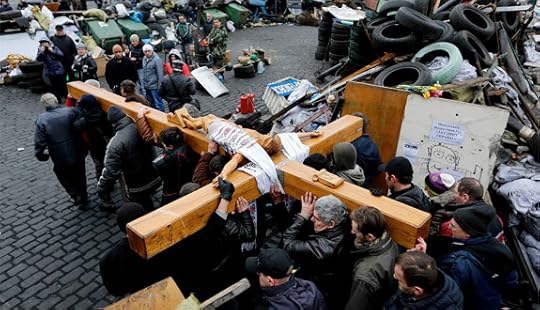Christians in Ukraine: Ecumenism in the Trenches

Mourners carry a large wooden crucifix past a barricade during a memorial procession in Independence Square in Kiev, Ukraine, Feb. 25. Dozens of protesters have been killed since November. (CNS photo/Yannis Behrakisi, Reuters)
Christians in Ukraine: Ecumenism in the Trenches | Fr. Cyril Hovorun | Catholic World Report
The conflict between the state and the society in Ukraine has led to a significant, and positive, shift in perspectives among Orthodox, Catholics, and Protestants
The religious map of Ukraine on the eve of the protests that began in November 2013, looked like a mosaic of military camps. The troops did not conduct active maneuvers nor openly attacked each other. They just stayed in their tranches, while their generals occasionally met on the neutral ground to imitate negotiations on truce, which none of them really wanted. The situation changed, however, when the civil protests began in November 2013 at the central square of Kiev, the Maidan of Independence. The civil awakening urged the Ukrainian churches to reconsider their relationship to each other. This followed the reconsideration of their relationship with the Ukrainian state and the society. The common fight for restoration of social justice and later on against the aggression of Russia provide the Ukrainian Churches a chance for reconciliation.
Statistics
Ukraine is religiously diverse. No one Church has a monopoly. The largest is the Ukrainian Orthodox Church (UOC) in communion with the Patriarchate of Moscow. According to the official statistics, in January 2013 it had 12,485 registered communities. This is the only Ukrainian church recognised by the fellowship of the Orthodox Churches worldwide. For 22 years the Primate of this Church was Metropolitan of Kiev Volodymyr Sabodan. In recent months, however, his health condition has dramatically deteriorated. For this reason on February 24, the Synod of this Church elected as Locum Tenens of the Kievan See Metropolitan Onufry.
The second largest Church is the Patriarchate of Kiev (UOC KP), which was founded in 1992 by the former exarch of Ukraine Filaret Denisenko, who was anathematised for this by the Patriarchate of Moscow. This Church, according to the same statistics, counted 4,536 registered communities in the beginning of 2013.
The third is the Ukrainian Autocephalous Orthodox Church (UAOC) with 1,205 registered communities. It originates from the Autocephalous movement that started in 1918, then moved into the emigration, mostly Canada and the US, and after Ukraine became independent, returned to its motherland as a UAOC.
There is also a Ukrainian Greek-Catholic Church (UGCC), a Catholic Church sui iuris, which follows the eastern rite. In January 2013, this Church counted 3,734 registered communities, mostly in the western Ukrainian region of Galicia. It nevertheless developed a distinct social teaching and has a powerful voice recognised throughout the whole country. The rest of the Ukrainian Churches, including the Roman Catholic Church with 919 communities, act publicly mostly through the All-Ukrainian Council of the Churches and Religious Organisations. This Council is the most effective platform of cooperation between different religious groups in Ukraine, including Jewish and Muslim.
Civil awakening
All major Ukrainian Churches, including the Greek-Catholic Church, belong to the eastern Christian tradition. According to this tradition, the Church gives priority to relations with the state, and not so much with the society. The Maidan, however, urged the Ukrainian Churches to begin realising that the unilateral relationship of the Church with the state is insufficient.
Carl E. Olson's Blog
- Carl E. Olson's profile
- 20 followers



